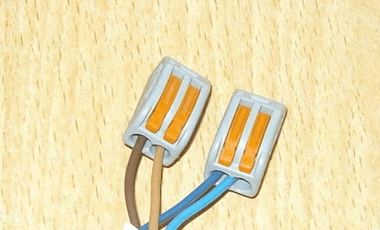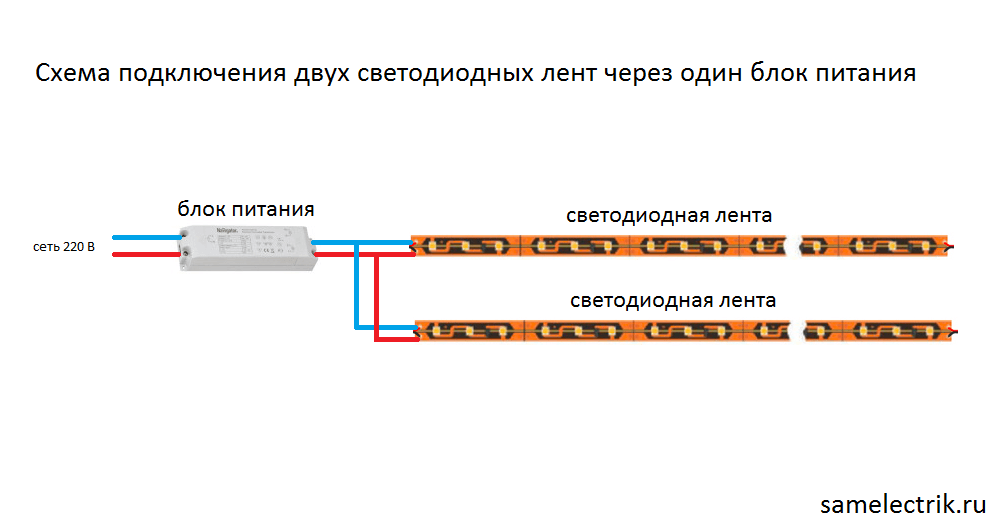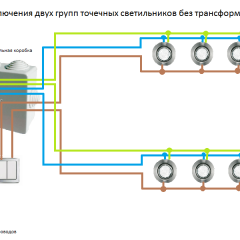4 best LED strip connection schemes
 So, to begin with, we bring to your attention a list of those materials and tools that you must have to connect:
So, to begin with, we bring to your attention a list of those materials and tools that you must have to connect:
- LED strip of suitable length;
- power supply unit (PSU, is a step-down transformer);
- bilateral connectors;
- wago terminal blocks;
- heat shrink tube (cambric);
- indicator screwdriver;
- side cutters;
- light switch.
Using the connectors, it will be possible to connect several LED strips into one (for example, if you need to add another 10-centimeter segment to the finished line). You can also use soldering, but this wire connection method It requires special soldering skills and more connection time.
Terminal blocks will be needed in order to quickly connect electrical wires with a parallel connection of several LED strips. Additionally, these products are protected by cambrices that carefully isolate the bonding points.
An indicator screwdriver is needed to determine the phase / zero (if missing wire color marking), as well as for tightening the screws in the terminals. With the help of side cutters it will be possible to cut the necessary piece of LED strip, although this is most often done with sharp scissors, as shown in the photo.
Well, the last device - the power supply (also called a transformer for LED strip), is used in the circuit in order to convert the 220V variables from the network into 12V constant, necessary to connect the lamp. The characteristics of this device are subject to special requirements - its power must be higher than the total power of one or more tapes connected in series. Otherwise, the room lighting will not be as effective, beautiful and durable as we would like.
So, we figured out the materials and tools, now we will consider the diagrams of connecting LED strips to the power supply unit and 220 Volt network with our own hands.
For starters, the simplest option that is used most often:
If you want to extend the length of the LED strip (usually sold in 5-meter rolls), then the product is either increased, or connected in parallel after the power supply, or connected in parallel to the mains with an individual power supply. Consider the diagrams when you need to apply each of the options.
In the event that the stackable piece is small (smaller than the new 5-meter roll), then you can simply connect the two segments together using a special connector (as shown below in the picture). In this case, the extension will not affect the intensity of the light flux, as well as the service life of the product.
The scheme for connecting two LED strips to the power supply:
If you decide to install the lighting in the room with two whole LED strips and at the same time the power of the PSU can ensure the normal operation of the two lamps, it is recommended to connect them in parallel, after the voltage transformer, as shown in the diagram below:
Well, the last option is used if the power of the lamps exceeds the maximum possible power of the power supply (for example, you decide to use 3-4 tapes with a total length of over 15 meters). Then from the network, each product must be connected through an individual power supply. This scheme of connecting LED strips is the safest, most effective and correct, because in this case there will be no voltage drops, and the PSUs themselves will have small dimensions (they can be hidden from the eyes in a special ledge).
That's all the most popular schemes for connecting LED strips to a 220 Volt network and a power supply. The only thing I would like to note is that the light switch is not indicated on the diagrams. It must be installed on the input in front of the power supply. Your business is already here - to buy a keyboard model or more modern, Dimmer. The latter option allows you to adjust the brightness of the LED strip, which is very convenient and popular today. We hope that this information was useful and understandable for you. If you have any questions, you can ask them to our experts in the comments or by going to the category ask a question to an electrician!
Related materials:









Hello. Tell me the connection scheme of three groups of LED strips to the controller with the remote control. Those. I need: 1. illumination above the doors of the wardrobe, 2. from the side the illumination of the shelves of the cabinet (they are outside) and 3. the illumination of the bed (maybe with the bed I feed the shelves above the TV). Remote control UNIEL UCH-P002-G3-1000W-30M. If possible, discard it by e-mail, although maybe someone will be interested too.
So what does not suit you the circuit that is depicted on the remote itself?
Yes, everything is clear with the circuit. I'm interested in the connection sequence! The controller "eats" 220V, and the LED strip is 12V. How many at the exit from the controller I did not find even. Therefore, I ask for advice - what should I do? After all, it turns out that for each group I need BP separately. And I wanted one for all groups (of course, with the calculation of power). But apparently, as they say, "dreamed one-eyed."
Hello, tell me can I connect as follows?
Power supply 200w => controller 144w => rgb tape 5 meters, 25w (5w / meter) => connector => rgb tape 5 meters, 25w (5w / meter) => connector => rgb tape 5 meters, 25w (5w / meter) => connector => rgb tape 5 meters, 25w (5w / meter)?
those. 4 rgb tapes are connected by connectors.
Thank!